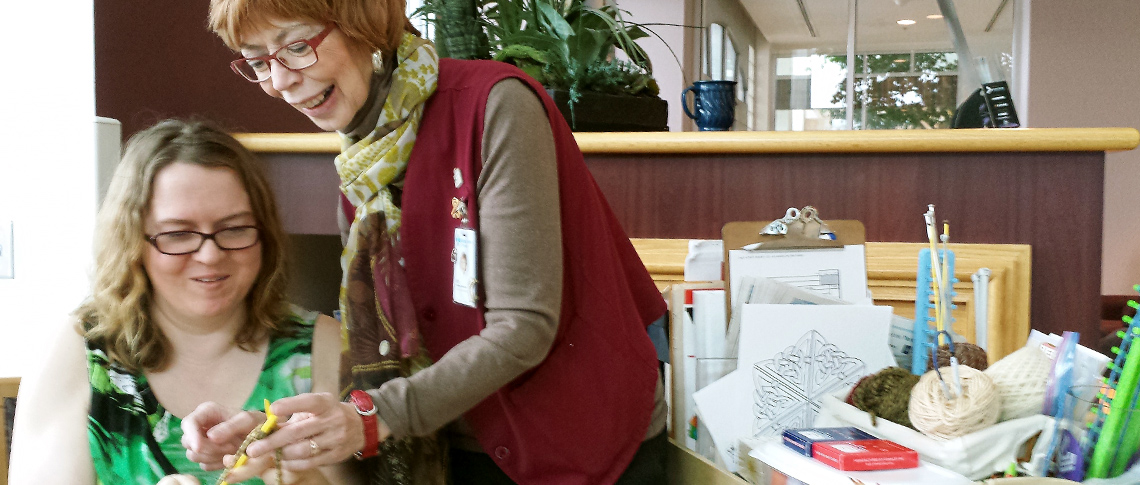
January 22, 2016

Long-time Cross Cancer Institute volunteer Debbie Hall-Lavoie shares some knitting materials from the Kindness & Creativity Cart with her colleague Tammy Detta in the waiting room. Out-patients and families waiting for appointments here can also enjoy books, magazines, bracelet-making, felting, colouring, card-making and other diversions thanks to the many activities available on the cart.
Story by Kristin Bernhard; Photo by Gregory Kennedy
EDMONTON — Waiting for an appointment for cancer treatment can now be a lot less boring thanks to an inventive pair of staffers here at the Cross Cancer Institute (CCI).
The Creativity and Kindness cart — created by volunteer resources coordinator Heather Dunn-Kinsman and art therapist Marie Butler — first rolled out at the CCI in early 2015 and continues to bring smiles, crafts and engaging activities to patients and families as it eases their anxiety and loneliness.
“The idea behind the creativity and kindness cart is to enhance patient care by providing an opportunity to occupy the wait time and reduce stress,” says Dunn-Kinsman. “The arts serve as therapeutic and healing tools and can have a positive impact on health outcomes.”
Loaded with craft supplies and reading materials, the cart is wheeled about by a small group of trained volunteers as they walk about waiting rooms to engage patients in a variety of free activities, which helps reduces anxiety as they await appointments.
“The arts contribute to what it means to be human, especially in times of illness,” says Dunn-Kinsman. “A continually growing body of research shows the qualitative and quantitative benefits of the arts within the healthcare setting.”
Activities offered are based on their cost, sustainability, infection control and ease of activity. The CCI Volunteer Association solely funds the cost of the cart.
Art projects on the cart include: creating greeting cards, felting, colouring, knitting with a loom or knitting needles and creating fabric bracelets.
Activity projects on the cart include: puzzles such as Sudoku, word search, crossword, brain teasers; playing cards and a cribbage board. Hannah Mast, a volunteer at the CCI since January 2015, has witnessed the impact of the cart firsthand.
“I was walking with the creativity cart and initially engaged in conversation with a middle-aged gentleman in the outpatient department,” she says. “He expressed interest in learning how to weave, so I showed him how, with one of our rectangular weaving looms.”
As Hannah sat in the chair beside the gentleman and showed him how to weave, he eventually began sharing his story about why he was at the CCI.
“His mother was receiving treatment and he was the only family member available to accompany her; her husband, his father, had passed away due to cancer years earlier,” says Mast.
“This gentleman expressed his fears — now that his mother is combating cancer — that he’s the only one left to carry the emotional burden and concerns.”
As he weaved, while sharing his feelings with Hannah, he began to cry.
“As he cried, he continued to show off to me what he was accomplishing,” adds Mast. “Amidst his tears he would turn to me, smile, and say ‘look how much I've done!’.”
“When his mother came out from her radiation treatment, she exclaimed, ‘you've taught my son to knit!’ (To which) he remarked, ‘I'm not knitting, Ma, I'm weaving!’”
Across the entire sitting area, interest soon piqued about how weaving works — and the one-on-one session quickly evolved into a group activity.
Mast’s experience with the gentleman is common. Many patients and staff express their gratitude for the cart and the items they’re able to make and bring home to loved ones.
“I approached a woman in the outpatient department, inquired if she would be interested in something to do while she waited, and she refused my offer,” says Mast.
“I stepped back, then sat down a few seats away and begin making a friendship bracelet, which I figured I could perhaps make and give to her. However, she took interest in what I was doing and started chatting with me.”
Mast soon learned how this patient used to make friendship bracelets, but didn't remember how. She also shared that she has two young daughters who would each love a bracelet.
“I encouraged her to pick out colours that her daughters would like so we could create bracelets together. I moved next to her with the cart and we both began crafting.”
By the time the patient was called to her appointment, the pair had managed to make three bracelets.
“She made one for herself,” says Mast. “She was ecstatic about giving the bracelets to her daughters. As we parted ways, her face was all smiles.”